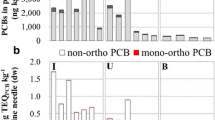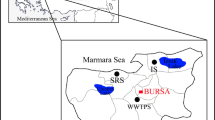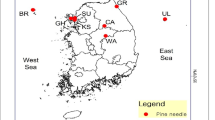Abstract
Pine needles were selected as cost-effective and easy collectable matrices suitable for long-term monitoring of the lower troposphere pollution with polycyclic aromatic hydrocarbons (PAHs). Overall, 27 sampling sites around the island of Crete were selected, and upon availability, second- and third-year needles from two pine species (Pinus brutia Ten. and Pinus pinea L.) were collected. In general, the results for both pine species showed that sites belonging in the urban group yielded the highest contamination levels when compared to the rural and the remote ones and that third-year needles had higher PAH contamination than the second-year ones. Phenanthrene was the prevailing PAH, representing 39% and 46% of the total contamination for second- and third-year needles, respectively. Fluoranthene, pyrene, chrysene and fluorene followed, with individual concentrations between 6% and 12%. The dominance of three-ringed PAHs was evidenced for the vast majority of the sites. An urban, rural and remote fingerprint was determined over a more general uniform contamination pattern, and the diagnostic PAH ratios pointed towards mixed petrogenic and pyrogenic sources. Overall, the present findings showed that the presence of PAHs is not negligible throughout the Cretan atmosphere and can be even considered quite high in some areas, especially when comparing the results to the ones found for more densely populated or industry-related areas.



Similar content being viewed by others
References
Baumard, P., Budzinski, H., & Garrigues, P. (1998). Polycyclic aromatic hydrocarbons in sediments and mussels of the Western Mediterranean Sea. Environmental Toxicology and Chemistry, 17, 765–776.
Blasco, M., Domeño, C., & Nerín, C. (2006). Use of lichens as pollution biomonitors in remote areas: comparison of PAHs extracted from lichens and atmospheric particles sampled in and around the Somport tunnel (Pyrenees). Environmental Science & Technology, 40, 6384–6391.
ΕΣΥΕ—National Statistical Service of Greece (2010). www.statistics.gr. http://www.statistics.gr/gr_tables/S1101_SAP_1_TB_DC_01_03_Y.pdf. Last accessed on 27 Mar 2010
EUR 22931 EN—Joint Research Centre—Institute for Environment and Sustainability (2007). Forest fires in Europe 2006. Authors: Paulo Barbosa, Giuseppe, Amatulli, Roberto Boca, Andrea Camia, Jan Kucera, Giorgio Libertà, Jesus San-Miguel Ayanz, Guido Schmuck, Ernst Schulte, and Hans-Helmut Dierks. Luxembourg: Office for Official Publications of the European Communities, 2007, pp. 77.
Gogou, A., Stephanou, E. G., Stratigakis, N., Grimalt, J. O., Simo, R., Aceves, M., et al. (1994). Differences in lipid and organic salt constituents of aerosols from Eastern and Western Mediterranean coastal cities. Atmospheric Environment, 28, 1301–1310.
Gogou, A., Bouloubasi, I., & Stephanou, E. G. (2000). Marine organic geochemistry of the Eastern Mediterranean: 1. Aliphatic and polyaromatic hydrocarbons in the Cretan Sea surficial sediments. Marine Chemistry, 68, 265–282.
Gorshkov, A. G. (2008). Determination of polycyclic aromatic hydrocarbons in the needles of a Scotch pine (Pinus sylvestris L.), a biomonitor of atmospheric pollution. Journal of Analytical Chemistry, 63, 805–811.
Holoubek, I., Kořínek, P., Šeda, Z., Schneiderová, E., Holoubková, I., Pacl, A., et al. (2000). The use of mosses and pine needles to detect persistent organic pollutants at local and regional scales. Environmental Pollution, 109, 283–292.
Hwang, H. H., & Wade, T. L. (2008). Aerial distribution, temperature-dependent seasonal variation, and sources of polycyclic aromatic hydrocarbons in pine needles from the Houston metropolitan area, Texas, USA. Journal of Environmental Science and Health Part A, 43, 1243–1251.
Hwang, H. H., Wade, T. L., & Sericano, J. L. (2003). Concentrations and source characterization of polycyclic aromatic hydrocarbons in pine needles from Korea, Mexico and United States. Atmospheric Environment, 37, 2259–2267.
IARC (International Agency for Research on Cancer). (1991). Monographs on the evaluation of carcinogenic risks to humans (pp. 43–53). Lyon: IARC.
Kylin, H., & Sjödin, A. (2003). Accumulation of airborne hexachlorocyclohexanes and DDT in pine needles. Environmental Science & Technology, 37, 2350–2355.
Lang, Q., Hunt, F., & Wai, C. M. (2000). Supercritical fluid extraction of polycyclic aromatic hydrocarbons from white pine (Pinus strobus) needles and its implications. Journal of Environmental Monitoring, 2, 639–644.
Lehndorff, E., & Schwark, L. (2004). Biomonitoring of air quality in the Cologne Conurbation using pine needles as a passive sampler—Part II: polycyclic aromatic hydrocarbons (PAH). Atmospheric Environment, 38, 3793–3808.
Librando, V., Perrini, G., & Tomasello, M. (2002). Biomonitoring of atmospheric PAHs by evergreen plants: correlations and applicability. Polycyclic Aromatic Compounds, 22, 549–559.
Liu, G. Q., Zhang, G., Li, J., Li, X. D., Peng, X. Z., & Qi, S. H. (2006). Spatial distribution and seasonal variations of polycyclic aromatic hydrocarbons (PAHs) using semi-permeable membrane devices (SPMD) and pine needles in the Pearl River Delta, South China. Atmospheric Environment, 40, 3134–3143.
Malawska, M., Bojakowska, I., & Wiłkomirski, B. (2002). Polycyclic aromatic hydrocarbons (PAHs) in peat and plants from selected peat-bogs in the north-east of Poland. Journal of Plant Nutrition and Soil Science, 165, 686–691.
Mandalakis, M., Gustafsson, Ö., Alsberg, T., Egebäck, A. L., Reddy, C. M., Xu, L., et al. (2005). Contribution of biomass burning to the polycyclic aromatic hydrocarbon contents in European background aerosols. Environmental Science & Technology, 39, 2976–2982.
Martens, D., Balta-Brouma, K., Brotsack, R., Michalke, B., Schramel, P., Klimm, C., et al. (1998). Chemical impact of uncontrolled solid waste combustion to the vicinity of the Kouroupitos ravine, Crete, Greece. Chemosphere, 36, 2855–2866.
Martínez, E., Gros, M., Lacorte, S., & Barceló, D. (2004). Simplified procedures for the analysis of polycyclic aromatic hydrocarbons in water, sediments and mussels. Journal of Chromatography. A, 1047, 181–188.
Mastral, A. M., Callén, M. S., López, J. M., Murillo, R., García, T., & Navarro, M. V. (2003). Critical review on atmospheric PAH. Assessment of reported data in the Mediterranean basin. Fuel Process Technology, 80, 183–193.
McLachlan, M. S. (1999). Framework for the interpretation of measurements of SOCs in plants. Environmental Science & Technology, 33, 1799–1804.
Mihalopoulos, N., Stephanou, E., Kanakidou, M., Pilitsidis, S., & Bousquet, P. (1997). Tropospheric aerosol ionic composition in the Eastern Mediterranean region. Tellus B, 49, 314–326.
Orecchio, S., Gianguzza, A., & Culotta, L. (2008). Absorption of polycyclic aromatic hydrocarbons by Pinus bark: analytical method and use for environmental pollution monitoring in the Palermo area (Sicily Italy). Environmental Research, 107, 371–379.
Piccardo, M. T., Pala, M., Bonaccurso, B., Stella, A., Redaelli, A., Paola, G., et al. (2005). Pinus nigra and Pinus pinaster needles as passive samplers of polycyclic aromatic hydrocarbons. Environmental Pollution, 133, 293–301.
Rappenglück, B., Melas, D., & Fabian, P. (2003). Evidence of the impact of urban plumes on remote sites in the Eastern Mediterranean. Atmospheric Environment, 37, 1853–1864.
Ratola, N., Lacorte, S., Alves, A., & Barceló, D. (2006). Analysis of polycyclic aromatic hydrocarbons in pine needles by gas chromatography mass spectrometry: comparison of different extraction and clean-up procedures. Journal of Chromatography. A, 1114, 198–204.
Ratola, N., Lacorte, S., Barceló, D., & Alves, A. (2009). Microwave-assisted extraction and ultrasonic extraction to determine polycyclic aromatic hydrocarbons in needles and bark of Pinus pinaster Ait. and Pinus pinea L. by GC-MS. Talanta, 77, 1120–1128.
Sarris, A., Maniadakis, M., Lazaridou, O., Kalogrias, V., Bariotakis, M., & Pirintsos, S. (2005). Studying land use patterns in Crete Island, Greece, through a time sequence of landsat images and mapping vegetation patterns. WSEAS Transactions on Environment and Development, 2, 272–279.
Simonich, S. L., & Hites, R. A. (1995). Organic pollutant accumulation in vegetation. Environmental Science & Technology, 29, 2095–2103.
St-Amand, A. D., Mayer, P. M., & Blais, J. M. (2009). Modeling PAH uptake by vegetation from the air using field measurements. Atmospheric Environment, 43, 4283–4288.
Stephanou, E. G. (1991). Analysis of anthropogenic and biogenic lipids in the aerosol of a coastal area in East Mediterranean Sea. Fresenius’ Journal of Analytical Chemistry, 339, 780–784.
Syllignakis, J., & Papazoglu, T. M. (2006). Study of impact on Crete system operation of the Atherinolakos power plant. In: Proceedings of the 41st International Universities Power Engineering Conference, vol. 2, pp. 482–485.
Terzakis, S., Fountoulakis, M. S., Georgaki, I., Albantakis, D., Sabathianakis, I., Karathanasis, A. D., et al. (2008). Constructed wetlands treating highway runoff in the central Mediterranean region. Chemosphere, 72, 141–149.
Tremolada, P., Burnett, V., Calamari, D., & Jones, K. C. (1996). Spatial distribution of PAHs in the UK atmosphere using pine needles. Environmental Science & Technology, 30, 3570–3577.
Tsapakis, M., & Stephanou, E. G. (2005a). Occurrence of gaseous and particulate polycyclic aromatic hydrocarbons in the urban atmosphere: study of sources and ambient temperature effect on the gas/particle concentration and distribution. Environmental Pollution, 133, 147–156.
Tsapakis, M., & Stephanou, E. G. (2005b). Polycyclic aromatic hydrocarbons in the atmosphere of the Eastern Mediterranean. Environmental Science & Technology, 39, 6584–6590.
Tsapakis, M., Stephanou, E. G., & Karakassis, Y. (2003). Evaluation of atmospheric transport as a nonpoint source of polycyclic hydrocarbons in marine sediments of the Eastern Mediterranean. Marine Chemistry, 80, 283–298.
Tsapakis, M., Apostolaki, M., Eisenreich, S., & Stephanou, E. G. (2006). Atmospheric deposition and marine sedimentation fluxes of polycyclic aromatic hydrocarbons in the Eastern Mediterranean basin. Environmental Science & Technology, 40, 4922–4927.
Wang, D. G., Chen, J. W., Xu, Z., Qiao, X. L., & Huang, L. P. (2005). Disappearance of polycyclic aromatic hydrocarbons sorbed on surfaces of pine [Pinus thunbergii] needles under irradiation of sunlight: volatilization and photolysis. Atmospheric Environment, 39, 4583–4591.
Wenzel, K.-D., Weißflog, L., Paladini, E., Gantuz, M., Guerreiro, P., Puliafito, C., et al. (1997). Immission patterns of airborne pollutants in Argentina and Germany. II. Biomonitoring of organochlorine compounds and polycyclic aromatics. Chemosphere, 34, 2505–2518.
Yunker, M. B., Macdonald, R. W., Vingarzan, R., Mitchell, R. H., Goyette, D., & Sylvestre, S. (2002). PAHs in the Fraser River basin: a critical appraisal of PAH ratios as indicators of PAH source and composition. Organic Geochemistry, 33, 489–515.
Acknowledgements
The authors wish to thank Fundação da Ciência e Tecnologia (Portugal) for the scholarship SFRH/BD/11970/2002 and the project PTDC-AGR-CFL-73156/06. Irama Sánchez, Dr. Alícia Navarro, Dr. Mònica Rosell and the authorities of the Samaria Gorge National Park are thanked for their collaboration in the collection of the samples.
Author information
Authors and Affiliations
Corresponding author
Rights and permissions
About this article
Cite this article
Ratola, N., Alves, A. & Psillakis, E. Biomonitoring of Polycyclic Aromatic Hydrocarbons Contamination in the Island of Crete Using Pine Needles. Water Air Soil Pollut 215, 189–203 (2011). https://doi.org/10.1007/s11270-010-0469-y
Received:
Accepted:
Published:
Issue Date:
DOI: https://doi.org/10.1007/s11270-010-0469-y




